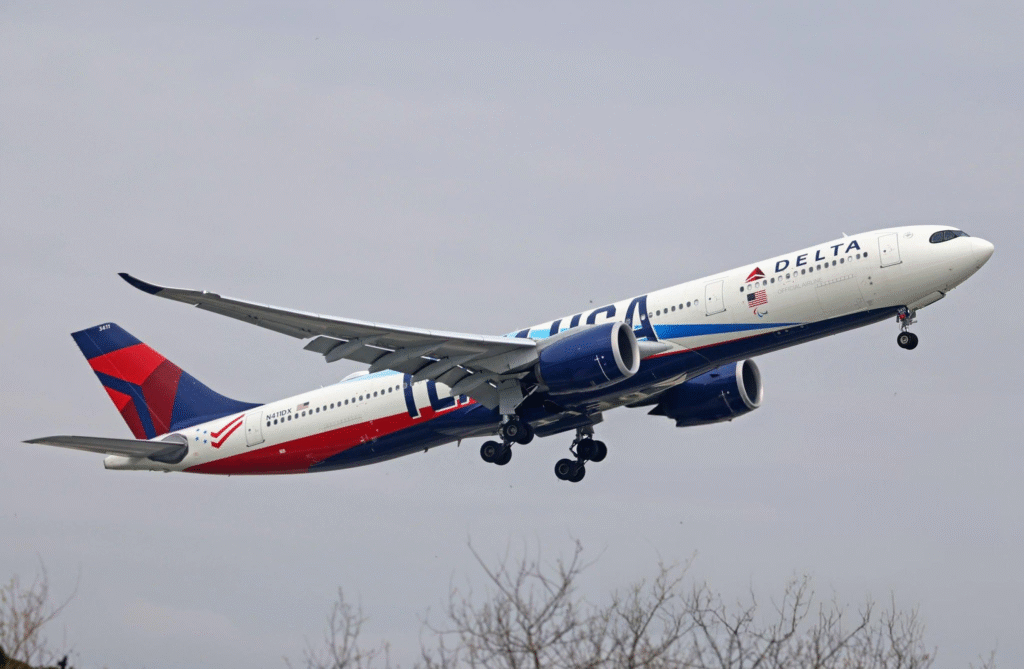On May 27–28, 2025, Delta Air Lines Flight DL275, an Airbus A350-900 traveling from Detroit (DTW) to Tokyo Haneda (HND), made headlines when it was forced to divert to Los Angeles International Airport (LAX). What began as a routine long-haul journey across the Pacific turned into a carefully managed emergency that highlighted the importance of aviation safety, infrastructure, and decision-making.
This article explores why DL275 diverted, what happened during the flight, how the crew managed the situation, and what lessons the aviation industry can take from this event.
The Flight Path and Initial Incident
Delta Flight DL275 departed Detroit Metropolitan Airport in the early hours of May 27, 2025, bound for Tokyo Haneda—a journey of nearly 6,400 miles. The Airbus A350-900, registered N508DN, was cruising at 38,000 feet, about 620 nautical miles southwest of Anchorage, Alaska, when the cockpit crew detected a problem.

The aircraft’s engine anti-ice system malfunctioned, a critical issue for flights operating in regions prone to icing. The Airbus A350 is powered by Rolls-Royce Trent XWB engines, and proper anti-icing is vital to prevent ice buildup on engine components. Without a functioning system, the risk of ice ingestion and engine damage grows significantly—especially over the cold North Pacific.
The Decision to Divert
With safety always the top priority, the pilots declared an emergency. The options available included returning toward Anchorage, continuing westbound toward Asia, or diverting southward. After consulting with Delta operations and considering weather, distance, and available facilities, the decision was made to head for Los Angeles International Airport (LAX).
This decision was influenced by several factors:
- Technical Facilities: LAX is one of Delta’s key international hubs, equipped with dedicated Airbus A350 maintenance hangars.
- Engine Support: Rolls-Royce maintains 24/7 support services at LAX, essential for diagnosing and repairing the Trent XWB engine systems.
- Operational Safety: LAX offers multiple long runways, favorable weather, and robust emergency response capabilities.
- Passenger Handling: As a major hub, LAX could accommodate overnight lodging, rebooking, and alternative connections for over 300 passengers.
The Diversion Flight
Instead of a direct route to Tokyo, the aircraft turned south toward California. After 12 hours and 15 minutes of flight time, DL275 landed safely on Runway 06R at Los Angeles International Airport.

Despite the emergency declaration, the landing itself was uneventful. The aircraft was met by emergency crews, but no smoke, fire, or visible damage was reported. All passengers disembarked normally, and no injuries occurred.
Passenger Experience
While no official passenger statements were widely published, aviation trackers and social media updates indicated a mix of relief and frustration. Passengers had prepared for a trans-Pacific journey, only to find themselves unexpectedly grounded in Los Angeles.
Delta reportedly provided:
- Hotel accommodations for those stranded overnight.
- Meal vouchers and transportation assistance.
- Rebooked connections to Tokyo Haneda and nearby Japanese airports on later flights.
Though inconvenient, the airline prioritized care and communication, which helped ease disruptions.
Financial and Operational Impact
Emergency diversions are costly. Analysts estimated that Delta’s immediate operational losses from DL275 exceeded $2.3 million, including extra fuel burn, crew logistics, and passenger accommodations. Broader estimates suggested the total cost could climb to $5.9 million when factoring in maintenance, lost revenue, and flight schedule disruptions.
However, airlines accept these costs as part of their “safety first” philosophy. Protecting lives and ensuring regulatory compliance far outweighs financial concerns.
Technical Background: The Anti-Ice System
Modern aircraft operate safely in a wide range of weather conditions, but engine icing remains one of the most serious risks in aviation. The anti-ice system:
- Uses bleed air from the engines to prevent ice accumulation.
- Ensures safe airflow into the engine’s fan and compressor.
- Protects sensors and probes from ice blockage.
When such a system malfunctions, pilots follow strict protocols: declare the issue, evaluate risks, and divert to the nearest suitable airport. The DL275 incident is a textbook case of how these safety systems work in real-world operations.
Why LAX and Not Anchorage?
At first glance, Anchorage might seem like the closer option. However, LAX offered superior advantages:

- Anchorage lacked the specialized A350 maintenance infrastructure needed.
- Weather near Alaska was less favorable, increasing risks for a diversion.
- LAX’s position allowed better rerouting for passengers onward to Asia.
This highlights how diversion decisions balance safety, logistics, and long-term operational impact.
Media and Public Reactions
Aviation enthusiasts tracked the flight closely via Flightradar24, with thousands following DL275’s unusual path south to Los Angeles. News outlets quickly picked up the story, though some provided conflicting explanations, ranging from “technical issues” to “medical emergencies.”
The most consistent and verified cause, however, remains the engine anti-ice system failure.
Lessons from the Incident
The DL275 diversion reinforces key aviation lessons:
- Safety Protocols Work – Pilots followed procedure and prioritized safety.
- Infrastructure Matters – Choosing LAX ensured rapid repairs and minimized disruption.
- Passenger Care Is Essential – Delta’s rebooking and accommodation efforts helped maintain trust.
- Transparency Matters – Clear communication from airlines reduces speculation and builds credibility.
Conclusion
Delta Flight DL275’s diversion to LAX may have been costly and disruptive, but it was a success in terms of aviation safety. No injuries occurred, passengers were cared for, and the aircraft received the attention it needed.
The event is a reminder that while air travel today is incredibly safe, unexpected technical issues can still arise. What matters most is how airlines and crews respond—and in this case, Delta and its pilots made the right call.
Frequently Asked Questions (FAQ)
1. What aircraft was used for Delta Flight DL275?
An Airbus A350-900, registered N508DN.
2. Where was DL275 originally headed?
The flight was bound for Tokyo Haneda Airport (HND) from Detroit (DTW).
3. Why did the pilots decide to divert?
Due to a malfunction in the engine anti-ice system, which posed risks in trans-Pacific conditions.
4. Why did the plane land in Los Angeles instead of Anchorage?
LAX offered specialized A350 facilities, Rolls-Royce support, and better passenger handling options.
5. How long was the flight before it landed at LAX?
About 12 hours and 15 minutes.
6. Were any passengers injured during the diversion?
No, all passengers landed safely without injury.
7. Did Delta provide compensation or accommodations?
Yes, passengers were rebooked and given hotel accommodations, meals, and assistance.
8. What was the estimated financial impact on Delta?
Estimates range between $2.3 million and $5.9 million in direct and indirect costs.
9. What is an aircraft anti-ice system?
It prevents ice formation on engines and sensors by using heated air or electrical elements.
10. What can travelers learn from this incident?
That diversions, while inconvenient, are necessary to ensure maximum safety in air travel.
Click for more amazing info. News Cora

